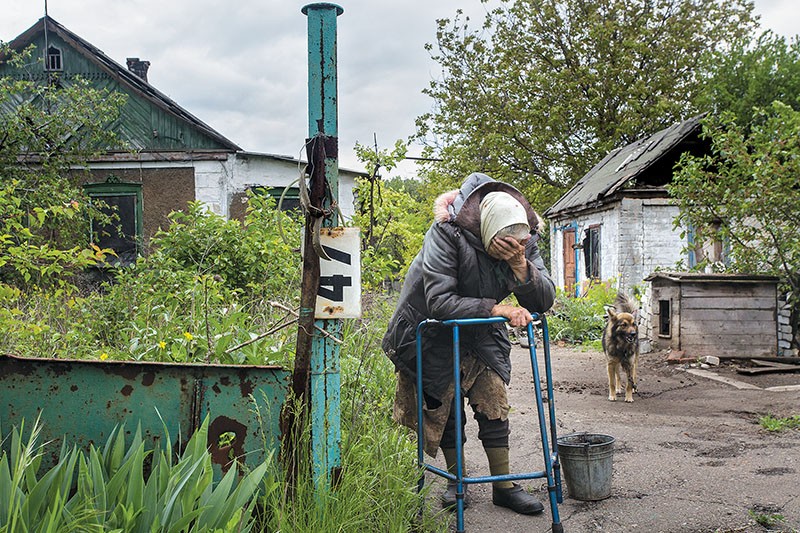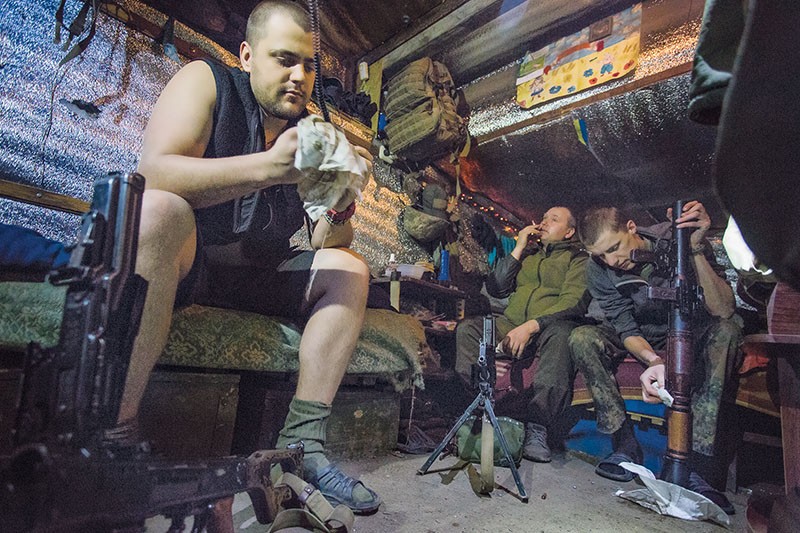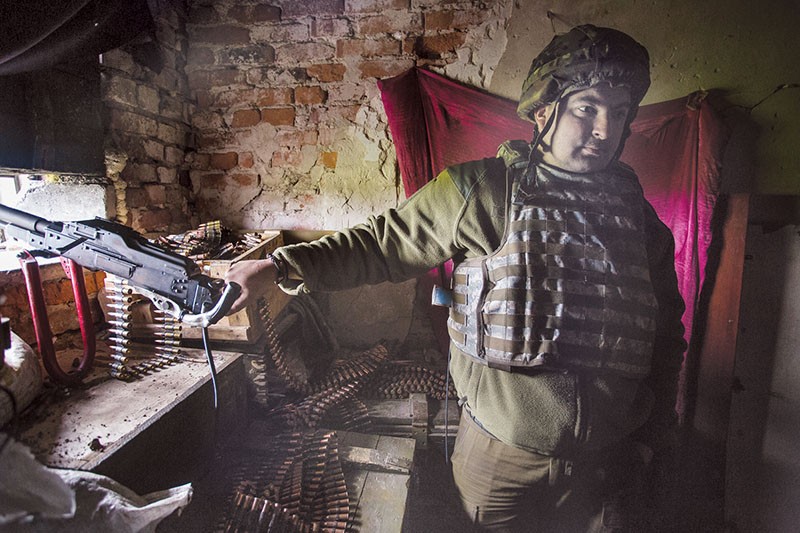PISKY, Ukraine — As the third spring of the war in eastern Ukraine turns to summer, eastern Ukraine’s embattled Donbas region is withering.
While the frontline dividing the country’s pre-war industrial heartland has remained largely static since the winter of 2014–2015, the exhausting stalemated war continues to depopulate the towns and villages in the war zone, leaving them desolate and ruined.
Pisky is one of the many Donbas towns on the front line that has been devastated by Russia’s war against Ukraine. A quiet settlement, bounded by several ponds and dense vegetation, it lies just northwest of Russian-occupied Donetsk, the stronghold of Russia’s proxy forces, some 700 kilometers east of Kyiv.
Pisky was home to over 2,000 people before the war. Many of the locals used to work in Donetsk, commuting there and back by public transport.
But in 2014–2015, the town found itself right on the front line of fighting for the nearby Donetsk Airport, a strategic position that both sides were determined to control. The nearest government-controlled settlement to the besieged Ukrainian defenders of the airport, Pisky was used as a supply base, and came under regular shelling by Russian-backed forces.
In January 2015, the last survivors of the airport garrison, nicknamed by their Russian enemies as “cyborgs” for their almost superhuman resilience, retreated to Pisky after 242 days of fierce fighting. Amid the battle, 95 percent of the town was damaged, and it was mostly abandoned by local civilians.

An elderly woman, Sofiya Tolmacheva, cries among damaged houses in the front-line town of Pisky on May 15. Tolmacheva is one of the few residents remaining in the town, unable to flee because she has to care for her disabled son. Another of her sons, injured in shelling, has since gone missing. She also cares for a dog left in the town by her neighbor. (Volodymyr Petrov)
Abandoned homes
Officially, 12 civilians still live in the town, although only four can be found in their ruined homes.
Sofiya Tolmacheva is one of them.
A woman in her 80s, Tolmacheva has nowhere else to go — her seriously disabled son needs constant care, and she has no contact with other relatives. Amid the mayhem of war in 2014, her other son sustained a severe head wound. He was hospitalized, and has since gone missing.
She does not even live in her own house — she and her son had to move into an abandoned building.
“On Sept. 3, 2014, a Ukrainian checkpoint not far from my home was shelled,” she says, wiping away tears. “Seven houses burned to the ground that day. And we had no chance to save our property — these were white phosphorous shells, and there’s no way you can put out the fires they cause.”
In her own yard alone, Tolmacheva found at least 34 impact craters, and some unexploded shells still remainn the ground there, she says.
“This war has no end in sight,” Tolmacheva says, crying. “And its main victims are us, ordinary local people. What are we guilty of?”
All of her neighbors fled the town long ago. Apart from caring for her son, she goes to her friend’s house every day to feed a chained dog — whose owner was driven insane by the endless shelling.
Her only sources of income are her tiny pension, brought to her every month by bank clerks from the nearest city, and some aid from others. Ukrainian soldiers say they bring food to the old woman and her son. They call her “Grandma Sonya.”
Another family of two elderly people who would identify themselves only as Svitlana and Anatoliy, live in the building next door. Their house was not seriously damaged, although several Grad rockets and mortar shells exploded in their garden, blasting down trees and fences.
The couple says there was a timein Pisky when the lightbulbs in their house would be knocked out of their fittings by the impacts of the shells. Many times they had to hide in their tiny cellar, spending sleepless nights on a mattress as the war raged above them.
“This cellar shelter has become a kind of local landmark,” his wife Svitlana says.
Although Anatoliy is unhappy with the army’s presence in the town, he says that the Ukrainian soldiers are friendly and helpful.
“Over the past year, the situation has been much quieter, and life has become slightly easier,” he says. “The Ukrainian soldiers connected our house to their electricity supply, so we’re plugged in all the time, we can listen to the radio to learn what’s going on. Besides, they sometimes give us some fuel for our car, so I can go shopping somewhere outside the town.”

Ukrainian servicemen clean their weapons after a clash with Russian-backed forces in the town of Pisky on May 15. The town, close to the ruins of Donetsk airport, a former Ukrainian stronghold that fell to the enemy in January 2015, is now right on the front line. (Volodymyr Petrov)
Dead town
Pisky has never recovered from the massive devastation it suffered in 2014–2015.
No building is untouched. Entire streets were flattened by artillery shelling. In the private housing sector, some of the rusty yard gates, riddled with holes from Grad rocket shrapnel, bear signs reading “People live here.” Ukrainian servicemen marked the houses with the last surviving civilians.
However, almost all of them have since been abandoned. The town’s three- and four-storey buildings are mostly heaps of bricks, with round holes in the walls that are still standing — evidence of direct hits by enemy tank shells. Hardly a window in the town is unbroken, and many balconies have collapsed.
The walls of the local school still bear painted farewells from children. None will come to study there this September — its roof was torn off by a massive explosion.
Most of the abandoned apartments have been looted. Caught under artillery fire, people fled their homes in a frantic rush, taking only bare essentials with them. In trashed apartments, clothes still hang in wardrobes, and dishes, furniture, dusty toys, books, and photo albums lie on the floor.
In some flats, smashed windows are covered with carpets that the last remaining civilians used to try to keep themselves warm amid relentless battle for the town, without heating or electricity. But only blackened walls remain in many flats.
Without people, Pisky’s narrow streets have become grown over with grass and bushes. Asphalt sidewalks are cracking, and silence has fallen over the empty town.

A Ukrainian soldier is seen on combat duty at a machine gun firing point in the Donetsk Oblast town on Pisky on May 15. The town is a hot spot in fighting between the Ukrainian army and Russian-backed forces, and has been left largely in ruins. (Volodymyr Petrov)
Mechanical beasts
The only signs of life are the combat units of Ukraine’s 80th Airmobile Brigade, who defend the town from positions just a kilometer from Donetsk Airport’s runway.
Soldiers manning trenches near a red brick church can see their enemy, just a few hundred meters away. Red flags, like Soviet-era military banners, hang over the Russian-backed fighters’ positions.
“Mind this — from our side, the church is mostly undamaged,” soldiers say. “But it’s been pummeled to dust by shooting from the Russians’ side.”
The Ukrainian fighters defending Pisky live in and fight from basements, rarely coming outside in daylight, their machine guns constantly trained on enemy positions.
“Here in Pisky, we’ve got two big problems — the enemy howitzers and their snipers,” says a Ukrainian officer who would identify himself only as Volodymyr and his codename “Doc.”
“Our defenses here are strong — we won’t let a mouse in — but we have to be alert all the time. Sometimes the Russians bring in their trainee snipers to test their skills on us. Those who get three successful shots are considered good enough for their elite forces.”
The 80th brigade in Pisky has several second-hand U. S. Humvee armored vehicles, provided by the United States to the Ukrainian army in 2015.
The Humvee’s side armor protects occupants from standard 7.62-millimeter rounds, and even from the more powerful 12.7-millimeter rounds fired from sniper rifles or machine guns, the soldiers say.
Although on the outside the vehicles are painted dark green as per Ukrainian standards, some are still painted yellow inside — a desert camouflage legacy from their time in Iraq.
“There was an incident with our Humvees when its front windshield was cracked by tank shell fragments,” says the vehicle’s gunner, Senior Sergeant Olexander Shklyaruk. “It’s a beast of a machine, but they’re not supposed to be engaged in this type of warfare. These Humvees would be great in urban war like in Iraq or Afghanistan, but not against Russian tanks in the open.”
“The separatists are freaked out when the American vehicles are thrown into battle against them in Pisky,” the soldiers say, laughing. “We often hear them talking via radio that it would be a matter of honor for them to knock out at least one Humvee with guided anti-tank missiles.”
However, not a single Humvee has been lost in battle yet, they say.
See more photos from Pisky in a special gallery from Volodymyr Petrov.
